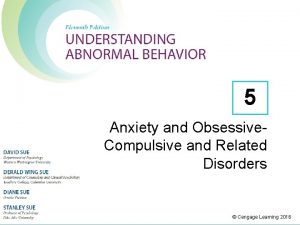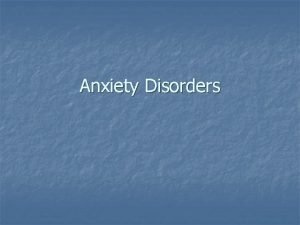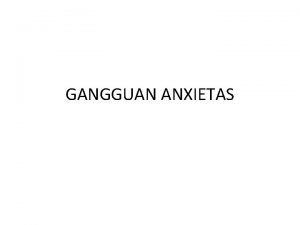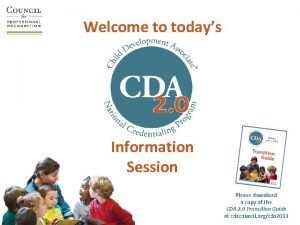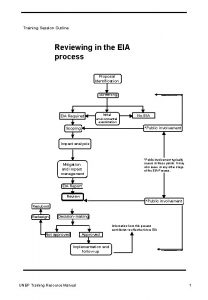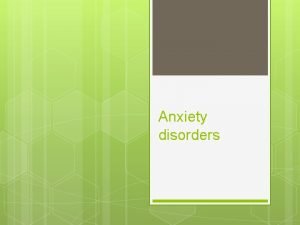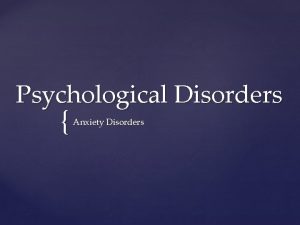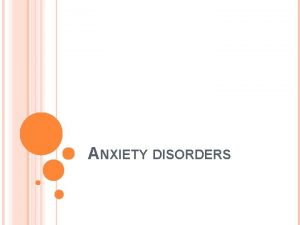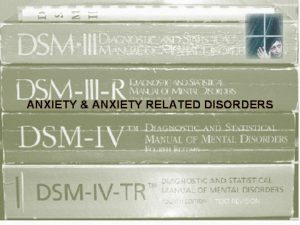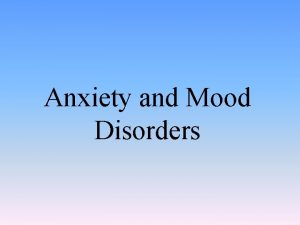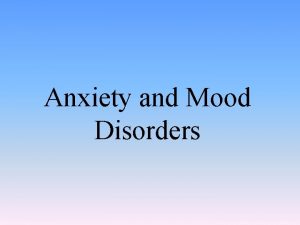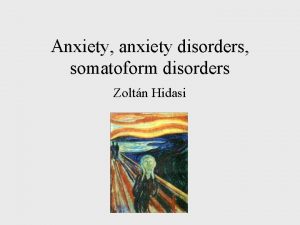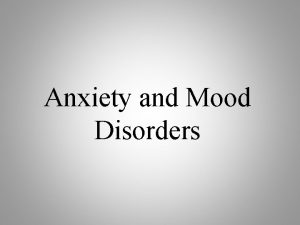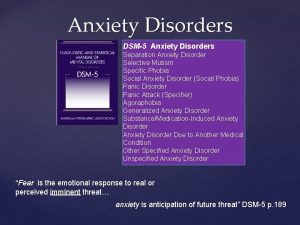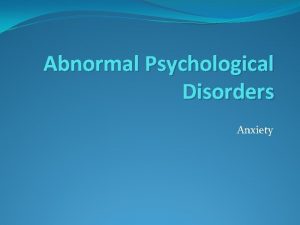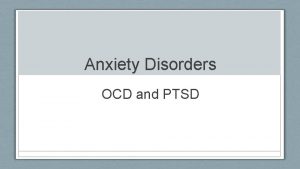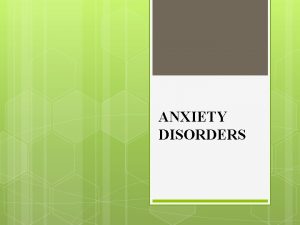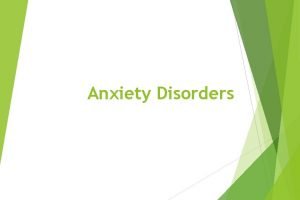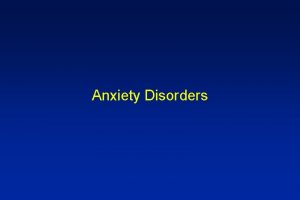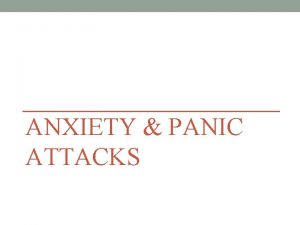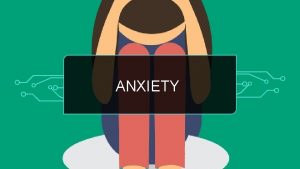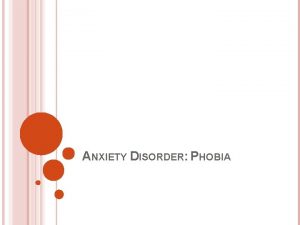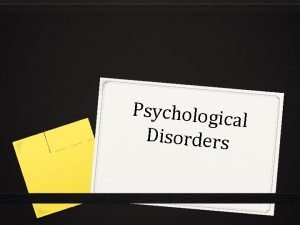Session II Anxiety Disorders 1 Outline for today


























































- Slides: 58

Session II Anxiety Disorders 1

Outline for today • Reflections from last day • Know-Wonder-Learn • Anxiety Disorders Ø Ø Ø Generalized Anxiety Disorder Social Anxiety Disorder Separation Anxiety Obsessive Compulsive Disorder Post Traumatic Stress Disorder Panic Disorder • What Educators can do • Reflection from today 2

Reflections From Last Day • Think of the students you currently support, have in the past or know of from schools you have worked in and respond to the following: ØHow have students with mental disorders been identified? ØWhat process is used to create a plan for supporting a student with a mental disorder? ØWhat is your involvement in the process of supporting the student? ØWhat support do you receive to prepare you for this task? 3

Know-Wonder-Learn • KNOW Øwhat you know about anxiety disorders Øhow students in schools present with an anxiety disorder • WONDER Øany questions you have concerning anxiety disorders that you hope to have answered • LEARN Øto be completed at the end of today’s session 4

FUNCTIONS OF THE BRAIN Thinking or Cognition Perception or Sensing Behavior Physical Functions Signaling (being Emotions responsive and reacting to the environment) ANXIETY

6

Why Do I Worry So Much? https: //www. youtube. com/watch? v=mq. Ppr_Y 0 Fmc 7

What is Anxiety? • Most children and youth experience worries and fears from time to time • These often change according to the developmental stage the young person is in • For example, an early primary student may be anxious about being separated from his or her parent when first starting school but an adolescent may be more concerned about peer acceptance 8

What is Anxiety? • Anxieties can be triggered by any number of common school experiences: ØTaking a test ØParticipating in class ØTrying out for a team ØInteracting with other students • Anxiety in these situations is normal and can be helpful in developing the motivation to succeed • Severe anxiety is a dysfunction of the Signaling Domain of the Brain • It can interfere with a student’s social, academic and/or emotional functioning 9

What Do Anxiety Problems Look Like? • Anxiety is primarily an internal experience for the individual • Outward behaviours and/or symptoms may not show themselves in obvious or disruptive ways • Anxiety manifest itself as: Øperfectionism Øavoidance Øprocrastination Øfeelings of being overwhelmed Øworries about time-limits or change in routine Øphysical aches and pains (e. g. headache or stomach-ache) 10

When Does Anxiety Become a Disorder? • Physical, emotional and behavioural responses to perceived danger are normal reactions • The ‘anxiety response’ is often automatic and every creature has these automatic responses as a way of protecting itself from danger • It becomes problematic when: Ø the frequency, intensity and/or duration is typically greater than what would be expected, given the context Ø it leads to impairment or disability at school, home or in social environments Ø it leads to avoidance of activities in an attempt to lessen the anxiety 11

Your Brain On Anxiety and Stress https: //www. youtube. com/watch? v=gmwi. J 6 gh. LIM Your Brain on Anxiety and Stress 12

How Common Are Anxiety Problems? • Anxiety is one of the most common mental health disorders (for children, adolescents and adults alike) • Recent research suggests approximately 8% of people will have an anxiety disorder at some point in life • The two most common disorders are: • General Anxiety Disorder (GAD affects up to 10% of children and adolescents) • Social Anxiety Disorder (SAD affects approximately 6% of children and 12% of adolescents) • Anxiety disorders are more common for girls than for boys 13

How Common Are Anxiety Problems? • The rates for anxiety disorders suggest that two or three students in any classroom may experience anxiety that is severe enough to interfere with their social and academic functioning • Anxiety is most commonly associated with mood disorders, particularly depression • A major depressive disorder is also present in 30 to 75 percent of pre-teens diagnosed with an anxiety disorder and 25 to 50 percent of adolescents 14

How Common Are Anxiety Problems? • Without treatment and intervention strategies, some anxiety disorders may last a lifetime • It is estimated that fewer than 20% of adolescents with anxiety disorders receive treatment • In adult life, these individuals may struggle with: Ø difficulty at work (or an inability to work) Ø social impairments Ø increased risk for other mental health disorders such as: - depression - substance misuse - suicidal thoughts 15

Anxiety Disorder Normal Anxiety Situation or trigger examples: Ø Ø Ø First date Preparing for an exam Performing at a concert Giving a speech Changing schools Climbing a tall ladder Persistent and excessive Interferes with normal functioning Leads to dysfunctional coping e. g. avoidance or First date Preparing for an exam Performing at a concert Giving a speech Changing schools Climbing a tall ladder Depends on the Situation Does not interfere significantly with normal life Does not prevent person from achieving goals withdrawal 16

Types of Anxiety Disorders 17

Generalized Anxiety Disorder (GAD) http: //www. shared-care. ca/vid. aspx? y=4 RSd. V 9 R 8 w. XQ 18

What is Generalized Anxiety Disorder (GAD)? 19

What is Generalized Anxiety Disorder? (GAD) • • Persistent and excessive anxiety and worry Occurs for an extended period of time Can be about a number of different stresses Causes significant distress and leads to physical symptoms 20

Characteristics of GAD • excessive anxiety and worry (usually out of proportion to the concern or the event) • occurring for an extended period of time (several days at a time) • anxiety and worry is noticeably greater than is typical for age group • focus of concern may be several different things (e. g. schoolwork, appearance, friends) • leads to the development of physical symptoms (headaches, fatigue, difficulty upset stomach, trouble sleeping) • symptoms tend to be chronic (often miss school or social activities due to physical symptoms) 21

Things not to miss • Some students with GAD may also deal with depression and/or panic disorder • The severity of the disorder may fluctuate according to levels of stress the young person experiences • Some students will begin to use and/or misuse substances as a way to cope with their anxiety • Some students may have suicidal thoughts 22

Learning To Manage Worry http: //www. shared-care. ca/vid. aspx? y=Dnu. RZH 0 f. Mdk 23

What is Social Anxiety Disorder? (SAD) • Sometimes termed Social Phobia • Intense fear of scrutiny by others • Feelings of extreme embarrassment or humiliation 24

Social Anxiety Disorder http: //www. shared-care. ca/vid. aspx? y=LFM 8 M 33 k 2 UI 25

Characteristics of SAD • Intense fear of social situations (young person is afraid they will do something humiliating or offensive in front of others, includes exposure to unfamiliar people) • Feel they may be considered flawed or worthless if performance is not perfect (others will judge them in a negative way) • May cope by trying to do everything perfectly or limiting what they do in front of others (May led to gradual withdrawal from contact with others) • Can experience panic symptoms in some situations (May avoid social situations and have difficulty attending class) • Recognize that fear is irrational but are unable to control it (fears may come and go over time, not to be confused with shyness) 26

Things not to miss • Some young people with SAD will misuse alcohol and/or other substances as a way to help decrease their anxiety in social situations • Some students with SAD may go on to develop a clinical depression – be watchful for indications • In young children, SAD may be appear similar to a Pervasive Developmental Disorder such as Autism • Children with SAD, in contrast to children with autism, will demonstrate age-appropriate relationships with family members or other familiar people 27

Steps to Social Success http: //www. shared-care. ca/vid. aspx? y=cl. SDRVw_4 PE 28

Separation Anxiety 29

What is Separation Anxiety? • It is normal for children to have some level of anxiety when saying goodbye to a parent • When the anxieties are persistent and get in the way of school or other activities it may be a separation anxiety • Some children experience a continuation or reoccurrence of anxiety during their elementary years and beyond • Since normal separation anxiety and a separation anxiety disorder share many of the same symptoms, it is often confusing as to which it is 30

What is Separation Anxiety? • The main differences between healthy separation anxiety and a separation anxiety disorder are: Øthe intensity of the child’s fears Øwhether these fears keep her/him from normal activities • Children with separation anxiety may become agitated at just the thought of being away from mom or dad • They may complain of illnesses to avoid playing with friends or going to school 31

Characteristics of Separation Anxiety Disorder • • Fear that something terrible will happen to a loved one Worry that there will be a permanent separation Nightmares about separation Refusal to go to school Reluctance to go to sleep Physical complaints, e. g. , headache or stomachache Clinging to caregiver 32

Common Causes of Separation Anxiety • Change in environment: Ø new house Ø starting school Ø change in day-care arrangement • Stress: Ø change in schools Ø loss of a loved one (including a pet) Ø parents separating • Over-protective parent: Ø sometimes it is the parent who is anxious Ø the parent and the child feed off one another’s anxiety 33

Separation Anxiety http: //www. youtube. com/watch? v=r. Lghx. G 3 m. GMM 34

Things not to miss • • • Age inappropriate clinginess or tantrums Consistent complaints of physical illness Withdrawal from friends and/or activities Refusing to go to school Excessive fear of leaving the If the separation anxiety seems to have come on suddenly, where it was not an issue previously, it may be the indication that the child has had a traumatic experience 35

Obsessive Compulsive Disorder http: //shared-care. ca/vid. aspx? y=dgb. Q 5 tn. Txto 36

What is Obsessive Compulsive Disorder? (OCD) 37

What is Obsessive Compulsive Disorder? (OCD) • OCD is an anxiety disorder characterized by obsessions and/or compulsions • Often begins in adolescence but can begin in childhood • Immediate family members of an individual with OCD are at a greater risk for developing the disorder • A young person with OCD will have significant symptoms of either obsessions, compulsions or both and should not be confused with either common double checking behaviours (common to many of us) or superstitions • OCD behaviours are time consuming, cause significant distress and interfere with the young person’s daily activities 38

Characteristics of OCD Obsessions • Obsessions are persistent, intrusive, unwanted thoughts, images or impulses • These obsessions cause significant distress to the young person and impacts his/her normal functioning • The young person generally recognizes that these obsessions are irrational, intrusive and inappropriate but is unable to control them • Obsessive thoughts are distinct from psychotic thoughts in that the young person realizes that these are their own thoughts, not something put inside them from elsewhere 39

Characteristics of OCD Compulsions • Compulsions are repetitive behaviours which the young person performs to reduce the anxiety of the obsessive thoughts • These compulsions are often time consuming and can lead to significant distress to the young person and impacts his/her normal functioning • Examples of these are counting, touching, washing and re-checking • Compulsions are distinct from psychotic behaviours in that the young person knows why he/she is doing the activity and can usually explain why they are doing it 40

Things not to miss • Youth with OCD are at high risk for developing clinical depression – be watchful for indications • Symptoms that appear to be those of an individual with OCD could actually be part of a psychosis – it is important to be aware of changes to baseline behaviour • Some students with severe OCD may attempt to involve their classmates and/or the adults in their compulsions – it is important to understand the disorder and not participate in the OCD rituals 41

Taking Steps to Manage OCD http: //shared-care. ca/vid. aspx? y=Wh. NFEAQ 1 q 4 A 42

What is Post Traumatic Stress Disorder? (PTSD) 43

What is Post Traumatic Stress Disorder? (PTSD) • Post traumatic stress disorder develops following a trauma that was either experienced or witnessed by the young person • It involves severe and persistent psychological response related to the trauma • These symptoms may include nightmares, flashbacks and/or hallucinations • The recollections of the trauma can be intrusive and distressing leading to significant impairment of normal day to day functioning 44

Characteristics of PTSD • Most people who experience a traumatic event will not develop PTSD • Risk factors include personal or family history of depression or anxiety and severity of the trauma • PTSD symptoms generally develop within 6 months of the traumatic event and are in three categories: Ø Re-experiencing Symptoms Ø Avoidance and Numbing Symptoms Ø Hyperarousal Symptoms 45

Characteristics of PTSD • Re-experiencing Symptoms: Ø Recurrent, intrusive, distressing recollections or memories of the event Ø May take the form of memories, dreams or flashbacks Ø The young person perceives him/herself reliving the event as though it were happening in the present 46

Characteristics of PTSD • Avoidance and Numbing Symptoms: Ø Avoidance of anything that reminds the young person of the traumatic event Ø This can include associations with people, places, topics of conversation, activities, situations, thoughts, etc. • The young person may also experience: Ø A general numbing of emotions Ø A lack of interest in previously enjoyed activities Ø Detachment from family and friends Ø Sense of hopelessness about the future 47

Characteristics of PTSD • Hyperarousal Symptoms: Ø Sleep problems, either difficulty falling asleep or staying asleep Ø Irritability Ø Angry outbursts Ø Hypervigilance Ø Exaggerated startle response Ø Difficulty concentrating 48

Things not to miss • Stress symptoms immediately following a traumatic event are NORMAL and do not require significant intervention • Exposure to trauma may cause pre-existing disorders such as anxiety, depression or psychosis to become more significant • Following a suicide, high-risk youth who were friends of the deceased, may be at significant risk • Substance abuse is common for individuals suffering from PTSD 49

What is Panic Disorder? • Recurrent, unexpected anxiety attacks • Involve the triggering of a number of physical reactions that are distressing or frightening to the young person • Frequency and severity can vary greatly • Onset is commonly between 15 and 25 years of age • If immediate family member(s) has Panic Disorder, likelihood for youth is 8 times greater 50

Characteristics of Panic Disorder • The young person experiences recurrent, unexpected anxiety attacks and greatly fear having another attack • They persistently worry about having another attack as well as the consequences of such an attack • Some fear they are losing their mind or even that they are going to die as a result of the attack • Will often change patterns of behaviour to avoid situations or places they fear will trigger an attack • May lead to some individuals avoiding almost everywhere but home 51

Symptoms of a Panic Attack • The young person has four or more of the following symptoms that peak within ten minutes: Ø Palpitations, accelerated heart rate Ø Sweating Ø Trembling Ø Shortness of breath Ø Feeling of chocking Ø Chest pain or discomfort Ø Nausea Ø Feeling dizzy, lightheaded or faint Ø Feeling of being detached from self Ø Fear of losing control or going crazy Ø Fear of dying Ø Numbness or tingling in body Ø Chills or hot flashes 52

What to do if a student has a Panic Attack • Identify the symptoms as a panic attack and reassure the student • Provide a calm and supportive environment until the attack passes • The EA can provide a helpful role, as outlined in the student’s support plan, by: Ø Assisting the young person during any panic attacks Ø Assisting the young person with his/her anxieties about having another attack Ø Assisting the young person with strategies to deal with their avoidance of social situations 53

Things not to miss • Youth with Panic Disorder are at high risk for developing clinical depression – be watchful for indications • Some students will begin to use and/or misuse substances as a way to cope with their anxiety • Some students may have suicidal thoughts 54

What if I suspect a student has an Anxiety Disorder? • Discuss your concern with the student’s classroom teacher • At the teacher’s discretion, this conversation may extend to the school counsellor and/or other members of the School Based Team • If concern is shared by the teacher and/or SBT: Ø note what the student’s previous or typical baseline behaviors were Ø begin an objective recording of the student’s current behaviours Ø determine if current behaviours interfere with the student’s typical functioning Ø Anxiety is highly treatable with cognitive behaviour therapy. A referral to the school counsellor is a good place to start 55

Jigsaw Activity • In teams, discuss the challenges present in a classroom with a student coping with any of the anxiety disorders discussed in today’s session • Form 4 different groups • Each group will have a handout on ways to support students with a specific anxiety that they will discuss as a team and familiarize themselves with • Participants will then rejoin their original team to both ‘teach’ the points they learned and to take notes on the topics the others covered • When finished, each team member will have a set of notes on supporting anxiety in the classroom 56

Know-Wonder-Learn • Look at your K-W-L sheet and review your responses to the first two sections • Correct any misconception that may have been recorded in the KNOW section • Take a few minutes and complete the LEARN section, especially concerning how it relates to what you had written in the section for WONDER 57

Reflections for Next Day • Think of a student you currently support (have in the past or know of from the school you work in) that is coping with anxiety. Respond to the following: ØWhat signs/symptoms of an anxiety disorder has the student displayed in the past? (answer this only if the information is something you and others have access to, do not refer to the student by name, be aware of privacy issues) ØHow is he/she currently being supported? ØHow has the student’s level of functioning improved as a result of the support? 58
 Multipath model of anxiety disorders
Multipath model of anxiety disorders Chapter 15 anxiety and obsessive-compulsive disorders
Chapter 15 anxiety and obsessive-compulsive disorders Anxiety disorders def
Anxiety disorders def Panic disorder icd 10
Panic disorder icd 10 Welcome to today's session
Welcome to today's session Welcome to today's session
Welcome to today's session Training session outline
Training session outline Galton details
Galton details For today's meeting
For today's meeting Today's lesson or today lesson
Today's lesson or today lesson Today class or today's class
Today class or today's class Example of repitition
Example of repitition Proposal kickoff meeting agenda
Proposal kickoff meeting agenda Sandwich quote example
Sandwich quote example Romarriket tidslinje
Romarriket tidslinje Tack för att ni lyssnade bild
Tack för att ni lyssnade bild Verksamhetsanalys exempel
Verksamhetsanalys exempel Shingelfrisyren
Shingelfrisyren Stål för stötfångarsystem
Stål för stötfångarsystem Shivaiter
Shivaiter Centrum för kunskap och säkerhet
Centrum för kunskap och säkerhet Inköpsprocessen steg för steg
Inköpsprocessen steg för steg Påbyggnader för flakfordon
Påbyggnader för flakfordon Lyckans minut erik lindorm analys
Lyckans minut erik lindorm analys Strategi för svensk viltförvaltning
Strategi för svensk viltförvaltning Sura för anatom
Sura för anatom Typiska drag för en novell
Typiska drag för en novell Standardavvikelse formel
Standardavvikelse formel Rutin för avvikelsehantering
Rutin för avvikelsehantering Tack för att ni har lyssnat
Tack för att ni har lyssnat Läkarutlåtande för livränta
Läkarutlåtande för livränta Iso 22301 utbildning
Iso 22301 utbildning Treserva lathund
Treserva lathund Myndigheten för delaktighet
Myndigheten för delaktighet Att skriva debattartikel
Att skriva debattartikel Tack för att ni lyssnade
Tack för att ni lyssnade En lathund för arbete med kontinuitetshantering
En lathund för arbete med kontinuitetshantering Tobinskatten för och nackdelar
Tobinskatten för och nackdelar Egg för emanuel
Egg för emanuel Tack för att ni har lyssnat
Tack för att ni har lyssnat Var finns arvsanlagen
Var finns arvsanlagen Programskede byggprocessen
Programskede byggprocessen Fuktmätningar i betong enlig rbk
Fuktmätningar i betong enlig rbk Presentera för publik crossboss
Presentera för publik crossboss Var 1721 för stormaktssverige
Var 1721 för stormaktssverige Vad är densitet
Vad är densitet Tack för att ni lyssnade bild
Tack för att ni lyssnade bild Tack för att ni har lyssnat
Tack för att ni har lyssnat Smärtskolan kunskap för livet
Smärtskolan kunskap för livet Referatmarkering
Referatmarkering Brant karttecken
Brant karttecken Epiteltyper
Epiteltyper Delegerande ledarskap
Delegerande ledarskap Lufttryck formel
Lufttryck formel Samlade siffror för tryck
Samlade siffror för tryck Personalliggare bygg undantag
Personalliggare bygg undantag Toppslätskivling dos
Toppslätskivling dos Elektronik för barn
Elektronik för barn Borra hål för knoppar
Borra hål för knoppar
